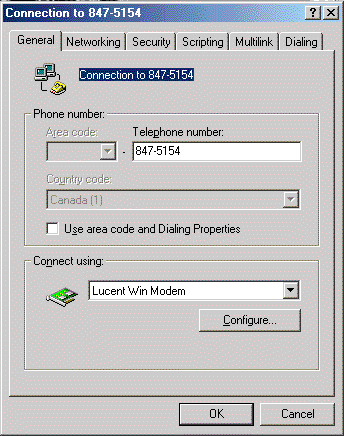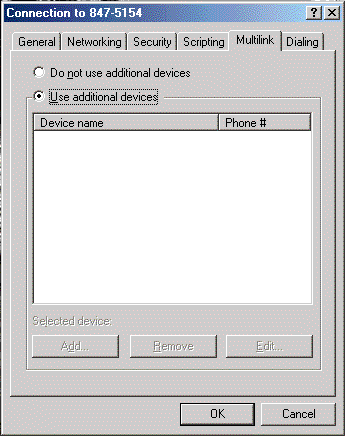|
When it comes to surfing the Web,
a fast, reliable connection is everything. With more Web sites
adding dynamic content and large pictures, going beyond the
text only HTML pages of the early years of the Web, a high
bandwidth connection is essential. ISDN, DSL (Digital Subscriber
Line) and Cable modems are the technologies most people are
talking about. These offer dramatic speed increases compared
to a 56K dial-up connection. ISDN is expensive and limited
to Point to Point connections. DSL and Cable modems are not
available in all areas of the country. So what can you do
to increase your bandwidth if you live in an area not serviced
by these new technologies or find the cost to high? Check
out MultiLink, a technology borrowed from ISDN and ported
over to Windows 98, ME and 2000. It allows you to use two
56K modems as one and effectively double your connection speed.
Of course, using MultiLink is a bit more involved than just
connecting two modems to your system, but it's not too difficult.
Note: DSL and Cable modems allow users to
send and receive data in megabits, or millions of bits per
second (Mbps). A 56K modem, sends and receive data in kilobits,
or thousands of bits per second (Kbps). However, keep in mind
that DSL and Cable modem systems vary widely and have different
speeds for download and upload. As such, it's difficult to
give exact connection speeds.
|
 |
Want faster access?
Try Multi-Link
Learn how to speed up your Internet
dial-up connection with a second phone line and a second modem.
The first thing that you need in order
to be able to take advantage of MultiLink is an ISP that supports
the MultiLink PPP technology. Cybernet offers this service
at no extra charge.
The second thing you need to use MultiLink
is the software. If you're running Windows 98, ME or 2000,
you're all set as far as software goes because MultiLink comes
with the operating system. If you're running Windows 95, you
need to download and install the Dial Up Networking 1.3 Performance
& Security Update. This includes the MultiLink software.
The next thing you need is two modems.
You can use two different speed modems, but this limits the
speed to that of the slower modem, using two of the same speed
will yield more satisfactory results. You can use any combination
of internal and external modems. You will need two separate
phone lines, one phone line for each modem.
About Multilink
MultiLink allows you to use two separate
modems as if they were a single modem. The MultiLink software
configures your modems to collaborate in such a way that your
connection speed is doubled. For example, if you have two
56K modems you'll essentially get a connection speed of 112K.
In order to attain this type of speed,
MultiLink intercepts data packets heading for the Internet,
splits them in two, and sends each half of the packet to a
separate modem. Each modem then sends a half packet to the
ISP. When the half packets reach the ISP, the server software
reassembles the original data packet and sends it out to the
Internet. On the return trip, a data packet heading from the
Internet to your computer is intercepted by your ISP's server,
which then splits it in two, and then sends a half-packet
back to each of your modems. The end result of this is that
your connection can handle Internet data in half the time.
This then equates to doubling your modem speed.
Note: As you may know, current CRTC regulations
limit a 56K modem's connection speed to 53 Kbps. Furthermore,
a speed of 53 Kbps is only possible if there is just one analog
switch between your modem and the phone company. If your connection
goes through more than one analog switch, which is very likely,
your modem's data transfer rate drops. As such, most people
using a 56K modem typically get a connection somewhere between
45 Kbps and 50 Kbps. This means that combining two 56K modems
with MultiLink will yield a connection speed of somewhere
between 90 Kbps and 100 Kbps.
Configuring software
Once all the equipment and phone lines
are set up, configuring MultiLink is easy. To begin, open
the Dial-Up Networking folder. If you signed up with a new
ISP, you'll need to double-click on the Make a New Connection
icon and create a new connection just like you normally would.
Once you create the new connection, or
if your using an existing connection, simply right-click on
your connection icon and select Properties from the shortcut
menu. When you see the connection property dialog box, select
the MultiLink tab.

Then, select the Use Additional Devices
option to enable the MultiLink configuration page.

Making A MultiLink Connection
To make a MultiLink connection, just
double-click on your connection icon in the Dial-Up Networking
window. When you do, you'll see the initial Connecting To
dialog box as you normally would. After the initial connection
is established, you'll hear the second modem begin dialing
the second connection.
As soon as Dial-Up Networking establishes
the second connection, double-click the connection icon in
the system tray. When you see the Connected To dialog box,
select the Details button to expand the dialog box, so that
you can see all the details.
You'll always get a connection that can
be evenly divisible by two. The reason being that the highest
connection that the second modem can establish must match
the speed of the first connection.
There is a Suspend button at the bottom
of the dialog box. When you click this button, the second
modem hangs up and the connection speed drops down to one
modem. This comes in handy if you need to free up one of the
phone lines to make a call, and still want to be connected
to the Internet.
When you disconnect the second modem, Dial-Up
Networking renames the button Resume. When you click the Resume
button, the second modem re-establishes its connection and
again doubles your connection speed.
Tip: When using two modems to establish
a connection with MultiLink, both modems negotiate the highest
connection speed that can reliably be supported under the
current conditions. There are many factors that can prevent
them from negotiating their maximum connection speed. These
situations are fairly common and aren't something you need
to worry about. If you don't feel that the current connection
speed is satisfactory, just disconnect and try the call again.
Unfortunately, DSL and cable modems aren't
yet available in all parts of the country. However, you can
double your connection speed with two lines, two modems and
Cybernet MultiLink.
|
